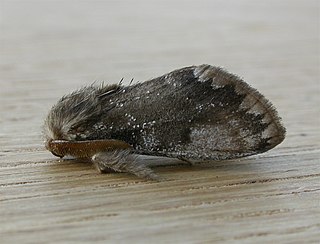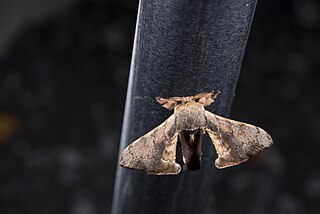
Heliothis is a genus of moths in the family Noctuidae. It was first described by Ferdinand Ochsenheimer in 1816. Some of the species have larvae which are agricultural pests on crop species such as tobacco, cotton, soybean and pigeon pea. Some species originally in this genus have been moved to other genera, see Chloridea and Helicoverpa.

Orgyia leucostigma, the white-marked tussock moth, is a moth in the family Erebidae. The species was first described by James Edward Smith in 1797. The caterpillar is very common especially in late summer in eastern North America, extending as far west as Texas, California, and Alberta.

Orgyia is a genus of tussock moths of the family Erebidae. The genus was described by Ochsenheimer in 1810. The species are cosmopolitan, except for the Neotropical realm.

Amastus is a genus of moths in the family Erebidae. The genus was erected by Francis Walker in 1855.
Andala is a monotypic tiger moth genus in the family Erebidae. Its only species, Andala unifascia, is found in the north-western Himalayas, Murree and Kussowlee. Both the genus and species were first described by Francis Walker in 1855.

Apantesis is a genus of tiger moths in the family Erebidae first described by Francis Walker in 1855. They are found in North and Central America.

Estigmene is a genus of tiger moths in the family Erebidae erected by Jacob Hübner in 1820. The species in the genus are native to North and Central America.

Eucereon is a genus of tiger moths in the family Erebidae. The genus was erected by Jacob Hübner in 1819.
Kodiosoma is a monotypic moth genus in the family Erebidae. Its only species, Kodiosoma fulvum, is found in Arizona, Nevada and California. Both the genus and species were described by Richard Harper Stretch in 1872.

Lophocampa is a genus of moths in the family Erebidae. The genus was erected by Thaddeus William Harris in 1841. It contains around 75 species.

Euproctis marginalis, the margined browntail moth, is a moth of the family Erebidae. The species was first described by Francis Walker in 1855. It is found in Australia, including Tasmania.

Spilosoma is a genus of moths in the family Erebidae originally described by John Curtis in 1825. A very heterogeneous group, it is in need of review by the scientific community, as certain species probably need reclassification into their own genera.

Catocala junctura, the joined underwing or Stretch's underwing, is a moth in the family Erebidae. The species was first described by Francis Walker in 1858. It is found throughout temperate North America, ranging from New York and Pennsylvania west to Montana, Colorado, Oklahoma, Arizona, and into Texas, and north to southern Illinois, extreme southern Alberta and Saskatchewan; it has also been recorded west of the Rocky Mountains from California and south-eastern British Columbia. It is typically found near water, where the food plants of its caterpillar larvae grow plentifully.

Idia rotundalis, the chocolate idia or rotund idia moth, is a litter moth of the family Erebidae. The species was first described by Francis Walker in 1866. It is found from southern Canada to Florida and Texas.

Trilocha varians, the Greenish silk-moth is a moth in the family Bombycidae described by Francis Walker in 1855. It is widespread in the Oriental region from India, Sri Lanka, China, extending to Taiwan, the Philippines, Pakistan, Sulawesi and Java.

Hemileuca is a genus of moths in the family Saturniidae first described by Francis Walker in 1855.

Ctenucha brunnea, the brown ctenucha or brown-winged ctenucha, is a moth of the family Erebidae. The species was first described by Richard Harper Stretch in 1872. It is found in the US from central to southern coastal California.
Calidota strigosa, the streaked calidota moth, is a moth of the family Erebidae. It was described by Francis Walker in 1855. It is found on the Antilles and from the southern United States to Central America.















